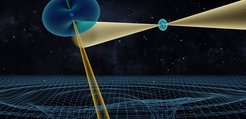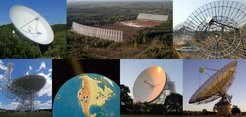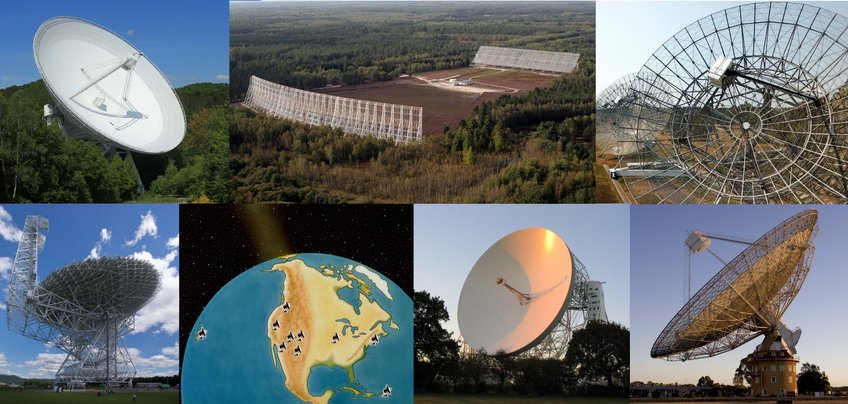Einstein wins again
The theory of general relativity passes a range of precise tests set by pair of extreme stars
An international team of researchers from ten countries led by Michael Kramer from the Max Planck Institute for Radio Astronomy in Bonn, Germany, has conducted a 16-year long experiment to challenge Einstein’s theory of general relativity with some of the most rigorous tests yet. Their study of a unique pair of extreme stars, so called pulsars, involved seven radio telescopes across the globe and revealed new relativistic effects that were expected and have now been observed for the first time. Einstein’s theory, which was conceived when neither these types of extreme stars nor the techniques used to study them could be imagined, agrees with the observation at a level of at least 99.99%.
The results are published in Physical Review X.

The picture at high resolution and two alternative versions (1b, 1c) are accessible in the left column.
More than 100 years after Albert Einstein presented his theory of gravity, scientists around the world continue their efforts to find flaws in general relativity. The observation of any deviation from General Relativity would constitute a major discovery that would open a window on new physics beyond our current theoretical understanding of the Universe.
The research team’s leader, Prof Michael Kramer from the Max Planck Institute for Radio Astronomy (MPIfR) in Bonn, Germany, says: “We studied a system of compact stars that is an unrivalled laboratory to test gravity theories in the presence of very strong gravitational fields. To our delight we were able to test a cornerstone of Einstein’s theory, the energy carried by gravitational waves, with a precision that is 25 times better than with the Nobel-Prize winning Hulse-Taylor pulsar, and 1000 times better than currently possible with gravitational wave detectors.” He explains that the observations are not only in agreement with the theory, “but we were also able to see effects that could not be studied before''.
Prof Ingrid Stairs from the University of British Columbia at Vancouver gives an example: “We follow the propagation of radio photons emitted from a cosmic lighthouse, a pulsar, and track their motion in the strong gravitational field of a companion pulsar. We see for the first time how the light is not only delayed due to a strong curvature of spacetime around the companion, but also that the light is deflected by a small angle of 0.04 degrees that we can detect. Never before has such an experiment been conducted at such a high spacetime curvature.”
This cosmic laboratory known as the “Double Pulsar” was discovered by members of the team in 2003. It consists of two radio pulsars which orbit each other in just 147 min with velocities of about 1 million km/h. One pulsar is spinning very fast, about 44 times a second. The companion is young and has a rotation period of 2.8 seconds. It is their motion around each other which can be used as a near perfect gravity laboratory.
Prof Dick Manchester from Australia's national science agency, CSIRO, illustrates: “Such fast orbital motion of compact objects like these - they are about 30% more massive than the Sun but only about 24 km across - allows us to test many different predictions of general relativity - seven in total! Apart from gravitational waves, our precision allows us to probe the effects of light propagation, such as the so-called “Shapiro delay” and light-bending. We also measure the effect of “time dilation” that makes clocks run slower in gravitational fields. We even need to take Einstein's famous equation E = mc2 into account when considering the effect of the electromagnetic radiation emitted by the fast-spinning pulsar on the orbital motion. This radiation corresponds to a mass loss of 8 million tonnes per second! While this seems a lot, it is only a tiny fraction - 3 parts in a thousand billion billion(!) - of the mass of the pulsar per second.”
The researchers also measured - with a precision of 1 part in a million(!) - that the orbit changes its orientation, a relativistic effect also well known from the orbit of Mercury, but here 140,000 times stronger. They realized that at this level of precision they also need to consider the impact of the pulsar’s rotation on the surrounding spacetime, which is “dragged along” with the spinning pulsar. Dr Norbert Wex from the MPIfR, another main author of the study, explains: “Physicists call this the Lense-Thirring effect or frame-dragging. In our experiment it means that we need to consider the internal structure of a pulsar as a neutron star. Hence, our measurements allow us for the first time to use the precision tracking of the rotations of the neutron star, a technique that we call pulsar timing to provide constraints on the extension of a neutron star.”
The technique of pulsar timing was combined with careful interferometric measurements of the system to determine its distance with high resolution imaging, resulting in a value of 2400 light years with only 8% error margin. Team member Prof Adam Deller, from Swinburne University in Australia and responsible for this part of the experiment, highlights: “It is the combination of different complementary observing techniques that adds to the extreme value of the experiment. In the past similar studies were often hampered by the limited knowledge of the distance of such systems.” This is not the case here, where in addition to pulsar timing and interferometry also the information gained from effects due to the interstellar medium were carefully taken into account. Prof Bill Coles from the University of California San Diego agrees: “We gathered all possible information on the system and we derived a perfectly consistent picture, involving physics from many different areas, such as nuclear physics, gravity, interstellar medium, plasma physics and more. This is quite extraordinary.”
“Our results are nicely complementary to other experimental studies which test gravity in other conditions or see different effects, like gravitational wave detectors or the Event Horizon Telescope. They also complement other pulsar experiments, like our timing experiment with the pulsar in a stellar triple system, which has provided an independent (and superb) test of the universality of free fall”, says Paulo Freire, also from MPIfR.
Michael Kramer concludes: “We have reached a level of precision that is unprecedented. Future experiments with even bigger telescopes can and will go still further. Our work has shown the way such experiments need to be conducted and which subtle effects now need to be taken into account. And, maybe, we will find a deviation from general relativity one day…”

The picture at higher resolution is accessible in the left column.
-----------------------------------------------------------------------
Additional Information
Radio pulsars – rapidly rotating highly magnetized neutron stars – are fascinating objects. Weighing more than our sun, yet only about 24 km in diameter, these incredibly dense objects produce radio beams that sweep the sky like a lighthouse. Since their discovery by Jocelyn Bell-Burnell and Antony Hewish in 1967, more than 3000 pulsars have been found. Pulsars provide a wealth of information about neutron star physics, the Galactic gravitational potential and magnetic field, the interstellar medium, celestial mechanics, planetary physics and even cosmology. They enable the strongest tests for predictions by gravity theories within extremely strong curved spacetimes.
The “Double Pulsar” PSR J0737-3039 A/B was discovered by members of the team (M. Burgay et al., 2003, Nature 426, 531-533; A. Lyne et al., 2004, Science 303, 1153). The first paper described a pulsar in a binary system whereas in the second paper the companion could be confirmed as a pulsar, too. It is the only system of two radio pulsars known to date. The source, in a distance of 2400 light years, was found in the direction of the constellation Puppis (directly to the left of Canis Major with Sirius, the brightest star in the night sky) in the course of a high-latitude multibeam pulsar survey with the Parkes radio telescope. The two pulsars are orbiting each other in just 147 minutes. One of them is spinning very fast, about 44 times a second whereas the younger companion has a rotation period of 2.8 seconds. The geometry of the system leads to eclipses of the pulsed emission of one pulsar by the magnetosphere of the other. Moreover, the geodetic precession of the rotational axis of Pulsar B has led to the temporary disappearance of the companion pulsar in 2008. Its reappearance depends on the details of its beam shape and may be as early as in a few months to years. The motion of two pulsars around each other makes them an almost perfect laboratory for tests of gravity.
Seven sensitive radio telescopes were used for the observations. They include CSIRO's Parkes radio telescope, Murriyang, in Australia (observations centered around 700 MHz, 1400 MHz and 3100 MHz), the Green Bank Telescope in the U.S. (observations at 820MHz and 1400/1500 MHz), the Nançay Radio Telescope in France (observations in two bands with central frequencies of 1484 MHz and 2520 MHz, respectively), the Effelsberg 100-m telescope in Germany (two different 20-cm receiver systems), the Lovell Radio Telescope in the UK (at 1300-1700 MHz frequency range), and the Westerbork Synthesis Radio Telescope in the Netherlands (observations at 334 MHz). In addition, observations with the Very Long Baseline Array (VLBA) with ten dishes distributed across the U.S. were used (at 1.56 GHz).
The research team consists of Michael Kramer, Ingrid H. Stairs, Richard N. (Dick) Manchester, Norbert Wex, Adam Deller, William A. Coles, Masooma Ali, Marta Burgay, Fernando Camilo, Ismaël Cognard, Thibault Damour, Gregory Desvignes, Robert Ferdman, Paulo C. C. Freire, Steffani Grondin, Lucas Guillemot, George B. Hobbs, Gemma Janssen, Ramesh Karuppusamy, Duncan R. Lorimer, Andrew G. Lyne, James W. McKee, Maura McLaughlin, L. Elias Münch, Nihan Pol, Andrea Possenti, John Sarkissian, Ben W. Stappers and Gilles Theureau.
The first author, Michael Kramer, and also Norbert Wex, Masooma Ali, Paulo Freire, Ramesh Karuppusamy and Elias Münch have an affiliation with the MPIfR.

